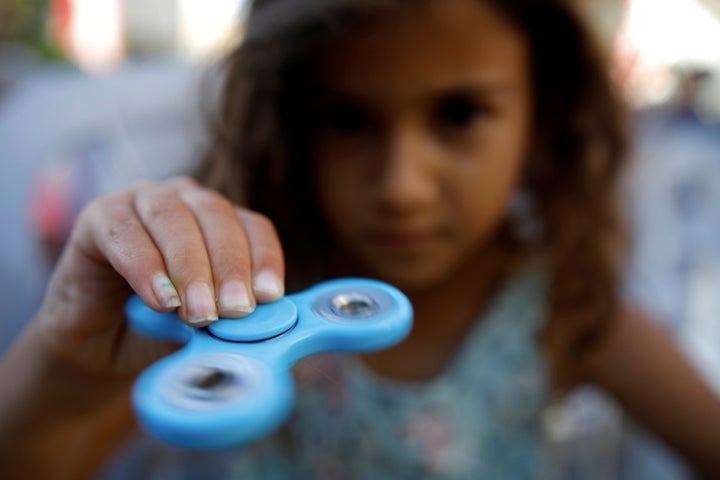
By Ian Bogost
There’s a new, dumb trend: the fidget spinner. It’s a toy like a top, but spun in the hand rather than on a surface. The user holds a pad at the center, and flicks one of three rounded blades. The spinner rotates around a bearing at the center. The light weight of the device and the low friction of the bearing allows it to spin for a long time.
What is it for? The fidget spinner has been framed as just a toy — but also as a stress-relief tool, a classroom menace, a treatment for ADHD, and a possible salve to smartphone addiction, among other things.
Fidget spinners might or might not be any of those things, but at their core they are something more, and something stranger: the perfect material metaphor for everyday life in early 2017, for good and for ill.
* * *
Toys similar to fidget spinners have been around for years, but over the last month or so the current incarnation has reached fever pitch. As with other cultural trends, like Flappy Bird and Pokémon Go, kids adopted the gadgets first. Since the winter, fidget spinners have invaded classrooms, causing teachers to confiscate them as contraband. They’ve become ubiquitous impulse purchases at mobile-phone shops and bodegas. And as I write this, fidget spinners dominate the Amazon.com bestsellers in toys and games.
RELATED: How Dove Ruined Its Body Image
As with any trend worthy of the name, fidget spinners have also produced both delight and moral panic. Classroom distraction became a concern and mental health an opportunity. Many spinners are explicitly marketed as stress relievers or even as self-care therapy for non-neurotypical conditions like ADHD and autism. There’s no scientific evidence to suggest that the toys offer legitimate treatment, but that hasn’t stopped people from using them that way — or issuing rejoinders to those who would try to stop them. Others have celebrated the tool as a salve for smartphone addiction — a doodad to keep the fingers busy so that they aren’t tempted to reach for that whimpering glass rectangle.
The devices have also inspired economic anxiety. An ordinary fidget spinner costs pennies to make and a couple dollars to buy, but some have tried to capitalize on the trend with luxury spinners costing hundreds of dollars or more. Affront erupted over the possibility that the toy’s inventor — an unassuming, 62-year-old, down-on-her-luck Florida inventor — has been cut out of the short-lived profits. Then subsequent affront erupted over the likelihood that those origin stories were misleading anyway.
All these signals merely trace the deeper meaning of the fidget spinner. It is a rich, dense fossil of the immediate present.
The top is not just one of the oldest toys, it is also one of the oldest artifacts of human civilization. Along with the earliest wheels, tops have been unearthed in ancient Mesopotamia dating back 5,500 years or more. The Egyptians had tops, too, some of which were found in the tomb of King Tut. Normally, a top is a toy requiring collaboration with the material world. It requires a substrate on which to spin, be it the hard earth of ancient Iraq or the molded-plastic IKEA table in a modern flat. As a toy, the top grounds physics, like a lightning rod grounds electricity. And in this collaboration, the material world always wins. Eventually, the top falls, succumbing to gravity, laying prone on the dirt.
RELATED: Is Donald Trump a Secret Redditor?
Not so, the fidget spinner. It is a toy for the hand alone — for the individual. Ours is not an era characterized by collaboration between humans and earth — or Earth, for that matter. Whether through libertarian self-reliance or autarchic writ, human effort is first seen as individual effort — especially in the West. Bootstraps-thinking pervades the upper echelons of contemporary American life, from Silicon Valley to the White House. But it also underwrites more marginal plights. When some non-neurotypical fidget spinners shun scientific verification of the device’s therapeutic value, they do so by affirming their individual ability — and right — to self-diagnose and self-treat.
In this context, a top that spins in the hand is like a pocket orrery — a mechanical model of the heavens. The fidget spinner quietly attests that the solitary, individual body who spins it is sufficient to hold a universe. That’s not a counterpoint to the ideology of the smartphone, but an affirmation of that device’s worldview. What is real, and good, and interesting is what can be contained and manipulated in the hand, directly.
“The spinner also conveys the impression that the individual has the power, even if only briefly, to overcome the laws of nature.”
The spinner also conveys the impression that the individual has the power, even if only briefly, to overcome the laws of nature. The spinner looks like a simple plastic gewgaw, but hidden within its body is a bearing around which the mechanism rotates. The bearing facilitates long spin times. The curse of friction, both real and symbolic, feels like it can be overcome in a universe of fidget spinners. And yet, the technological slight-of-hand that makes long spins possible is obscured, as if it were natural. Makers of toy tops have been attempting to overcome friction for years: The record for the longest top spin stands at over 51 minutes. But that top is non-mechanical, unlike the fidget spinner — which only spins for a minute or so anyway.
But the fidget spinner is only partly a toy. As much or more, it is a topic on the internet and a product in the market. Online, the device becomes #content: posts, tweets, and Snaps from the public, along with thousands of words from the press — including my own here, in the takiest of takes. All strive to get to the bottom of every phenomenon, to contain it, to make it theirs.
In the case of the fidget spinner, the temporary victory of joining in the commentary also offers succor. In an uncertain global environment biting its nails over new threats of economic precarity, global autocracy, nuclear war, planetary death, and all the rest, the fidget spinner offers the relief of a non-serious, content-free topic that harms no one. At a time when so many feel so threatened, aren’t handheld, low-friction tops the very thing we fight for?
Then commerce validates the spinner’s cultural status. For no cultural or social trend is valid without someone becoming wealthy, and someone else losing out. And soon enough, the fidget spinner will stand aside, its moment having been strip-mined for all its spoils at once. The only dream dreamed more often than the dream of individual knowledge and power is the dream of easy, immediate wealth, which now amounts to the same thing.
* * *
The purest medium is the one that is unable to carry any content. For Marshall McLuhan, the best example was the electric light. Unlike the newspaper or the television, the lightbulb doesn’t disseminate images, ideas, or information. Instead, it changes the capacity to see in environments. Nighttime becomes activated, transformed into a place where labor can continue beyond sunset, or where baseball games can fill evenings and not just weekends.
Today, the internet-connected, global economy exerts influence like the electric light once did. Gizmos like the fidget spinner fuse just-in-time manufacturing, global logistics, marketing, retail, and publishing. They exist not to serve a purpose, like play or mental health, but to grease the machinery that fulfills the desire it also invents.
The same values that the fidget spinner symbolizes, like innovation and individualism, are supposed to produce a glorious future: life-extending technology, on-demand delivery, and hyperloop transit. But in truth, progress has ground to a halt. In its place: an infinite supply of gewgaws, whether apps or memes or tops. Each fashions a new itch, whose scratch offers a tiny, temporary relief that replaces broader comforts.
This story originally appeared on TheAtlantic.com.
More from The Atlantic: When Your Child Is a Psychopath, My Family’s Slave
